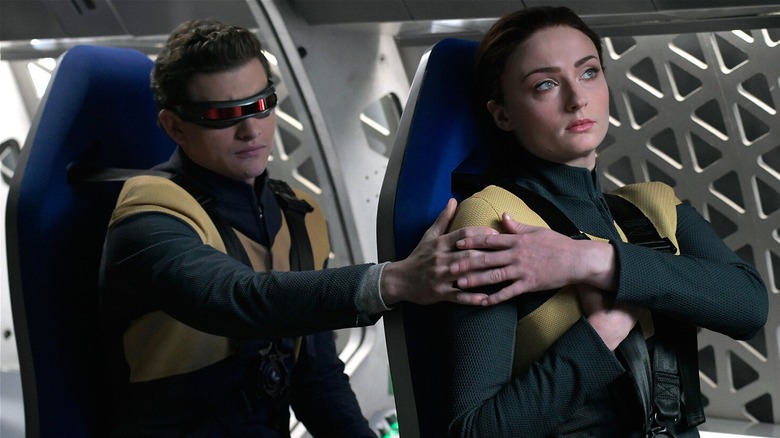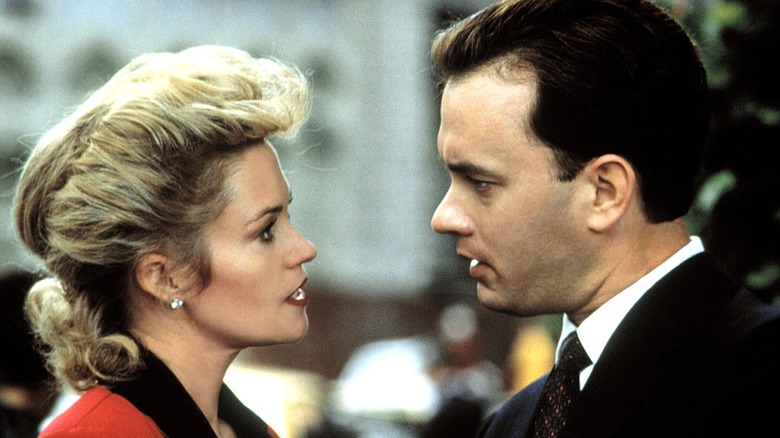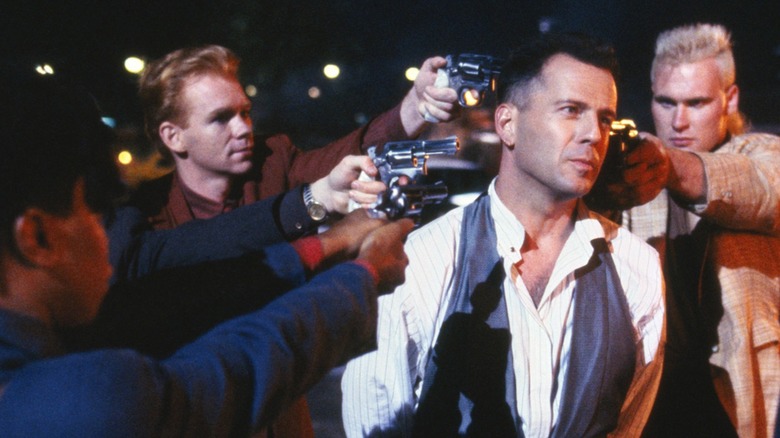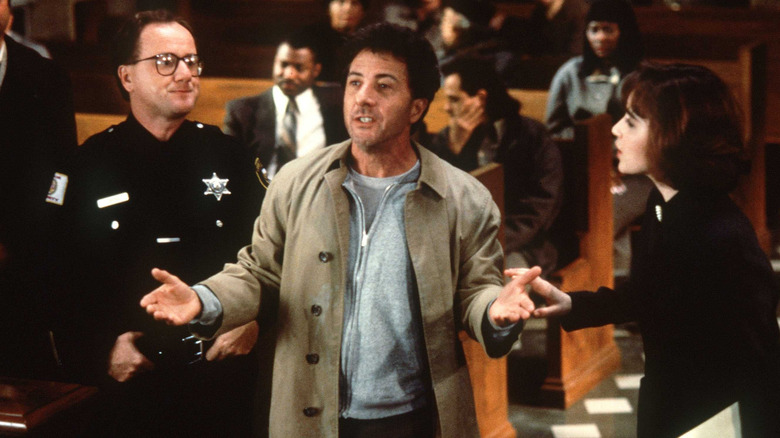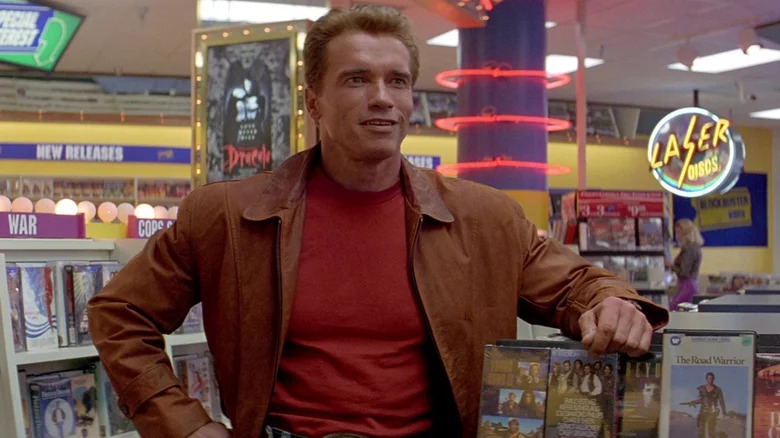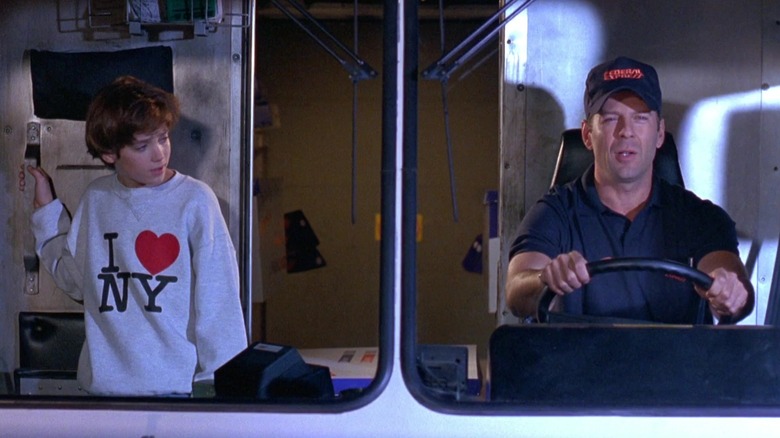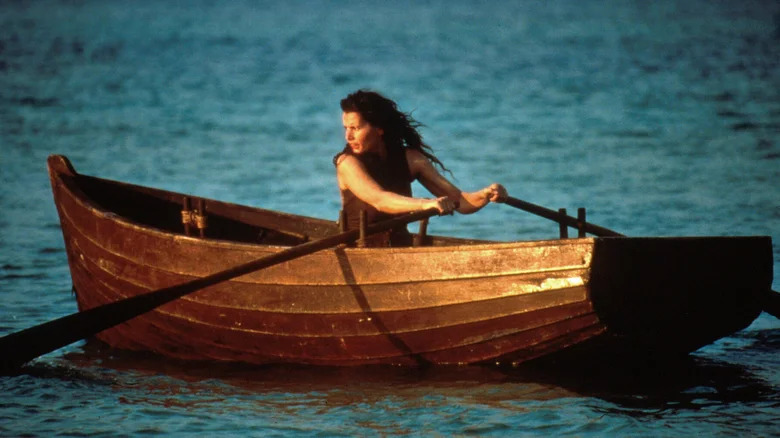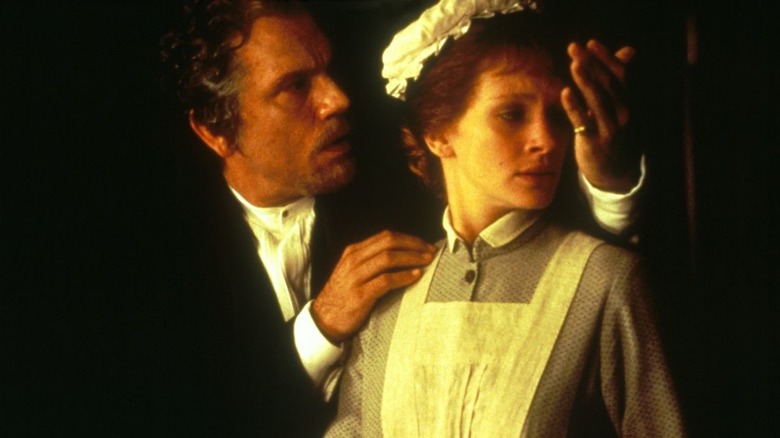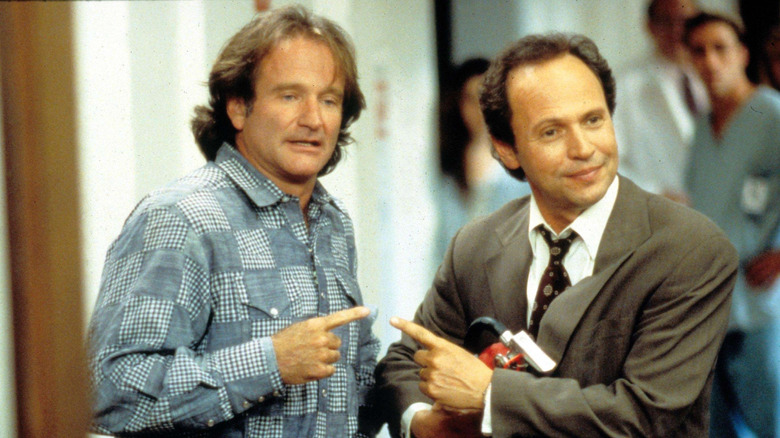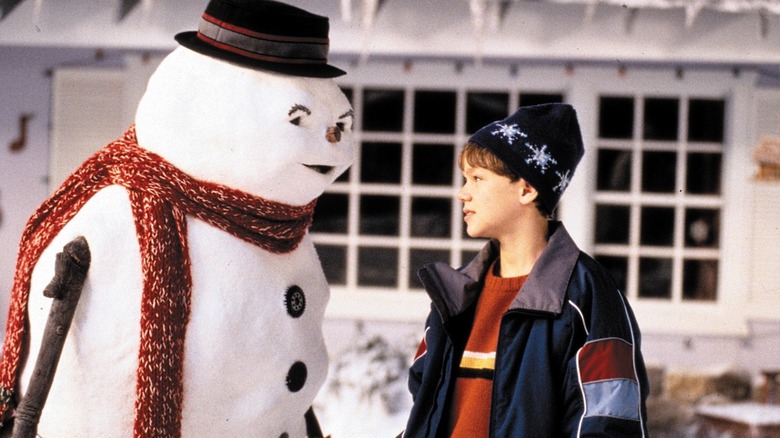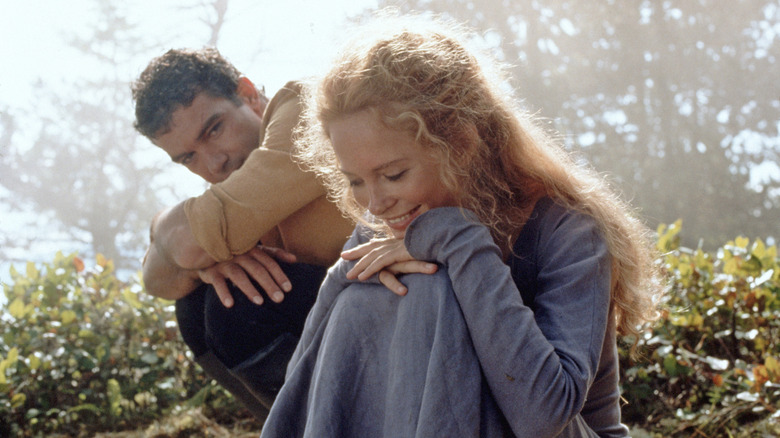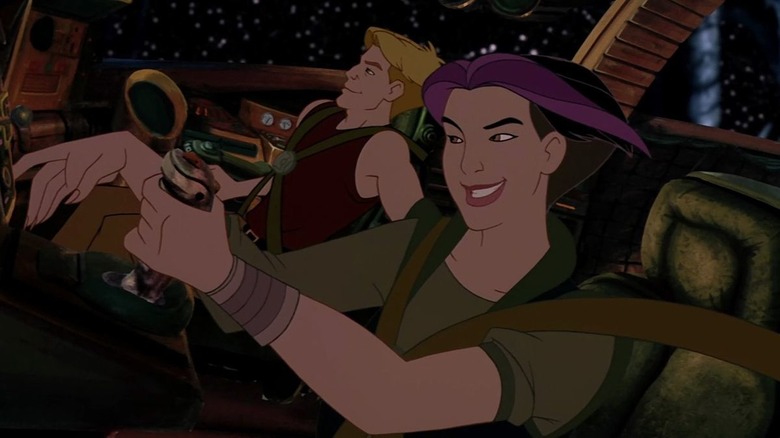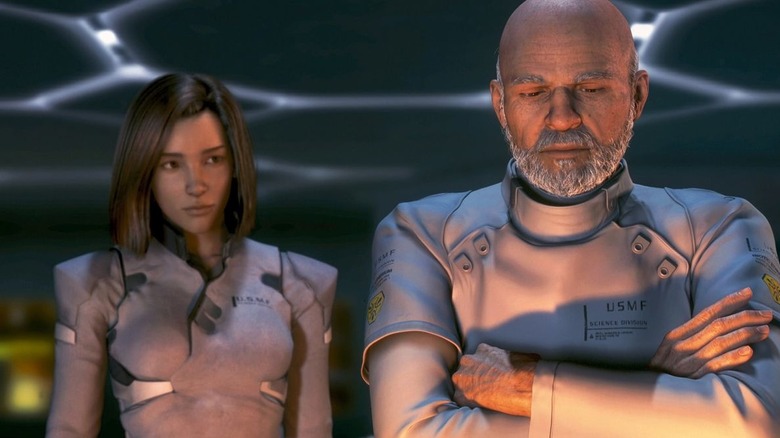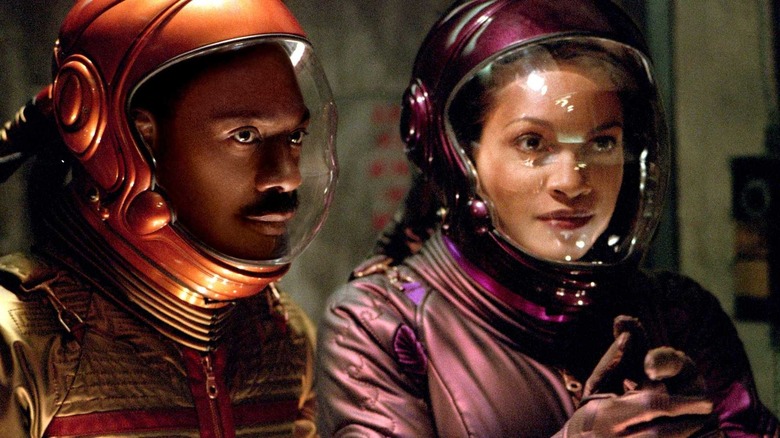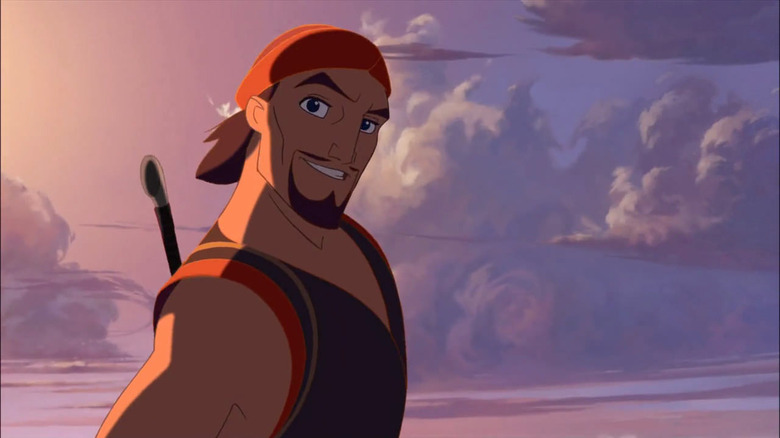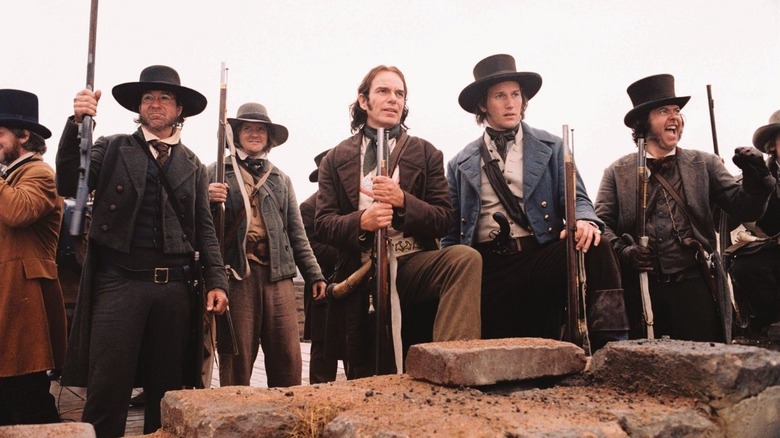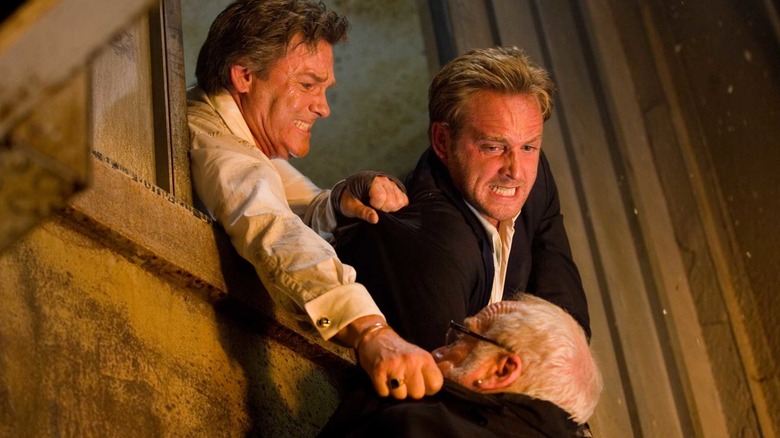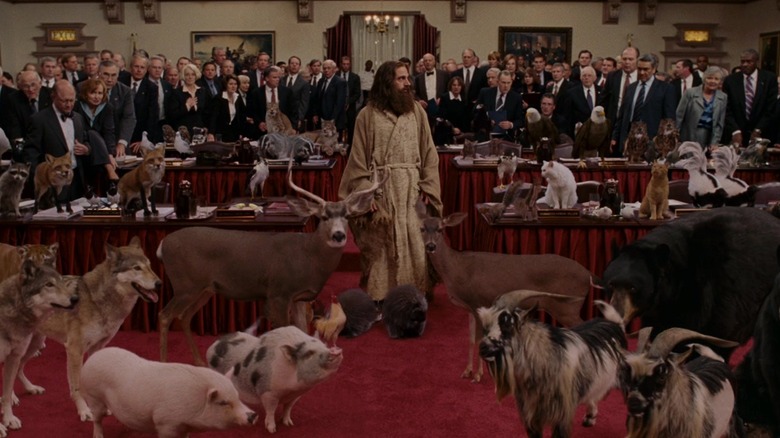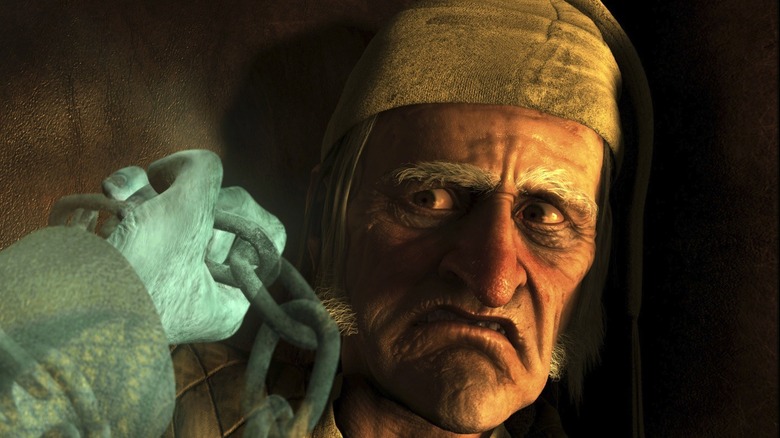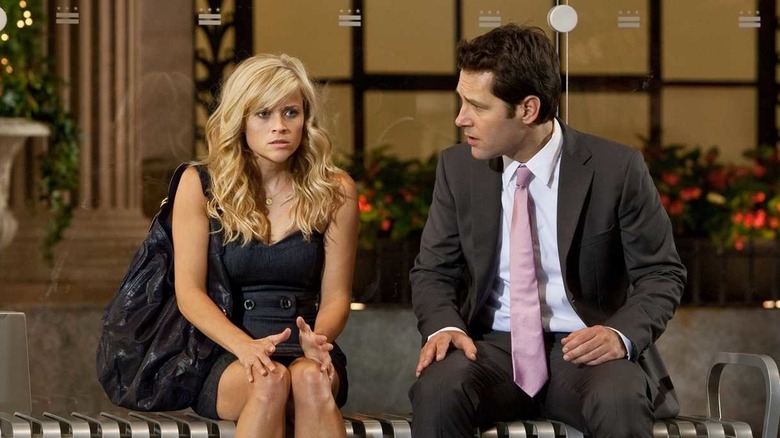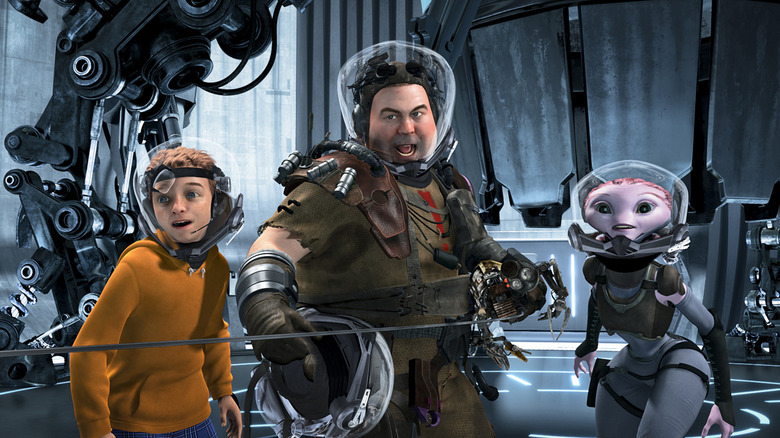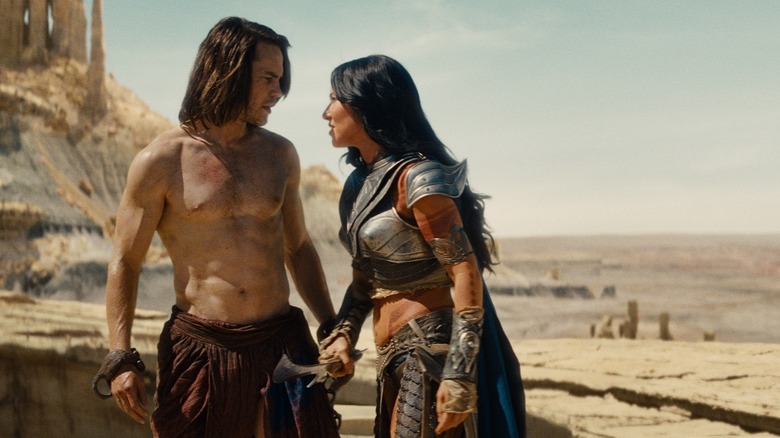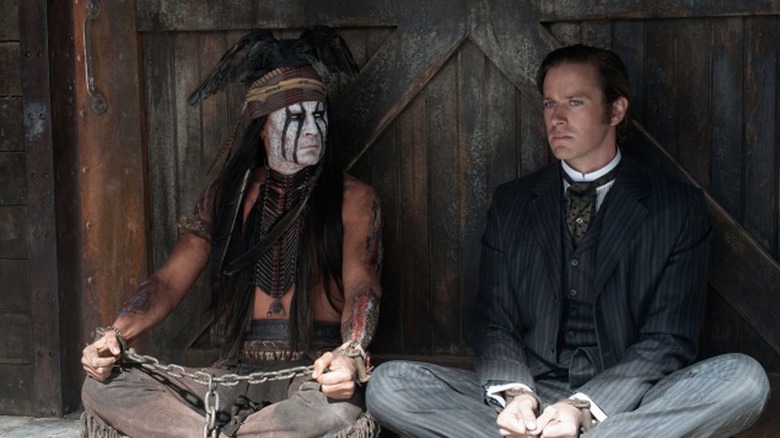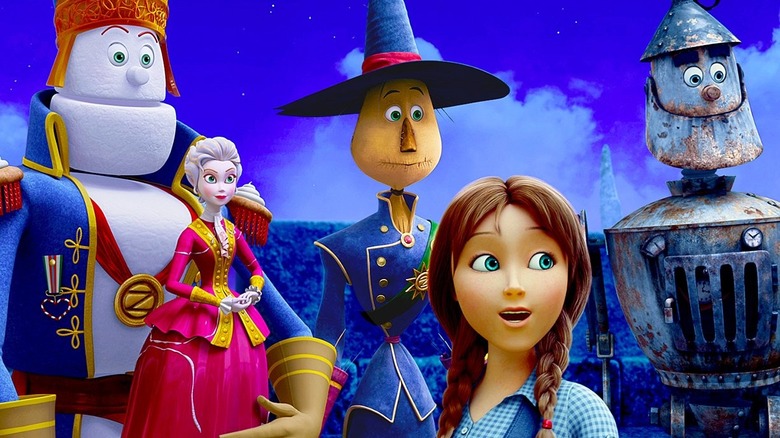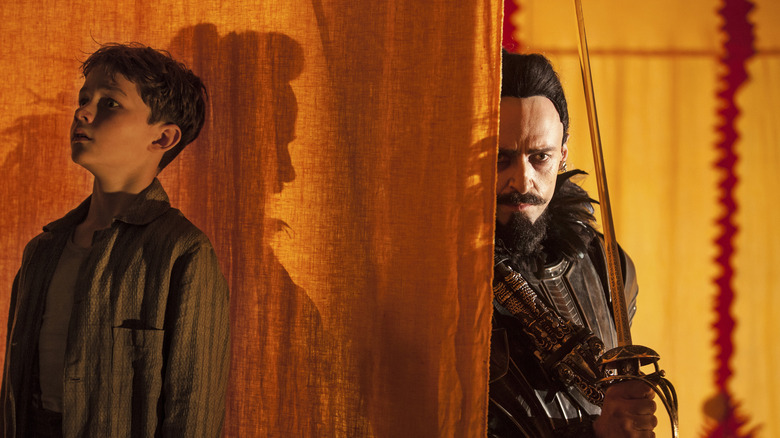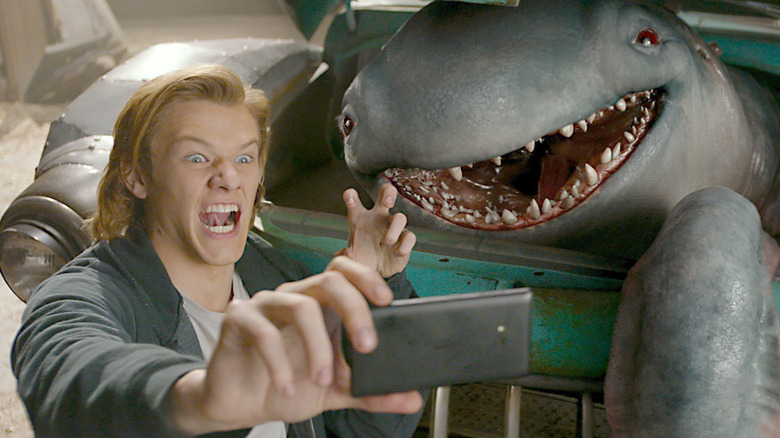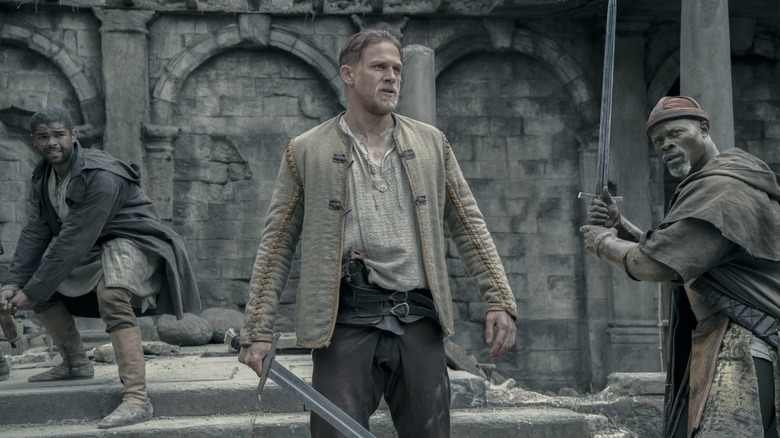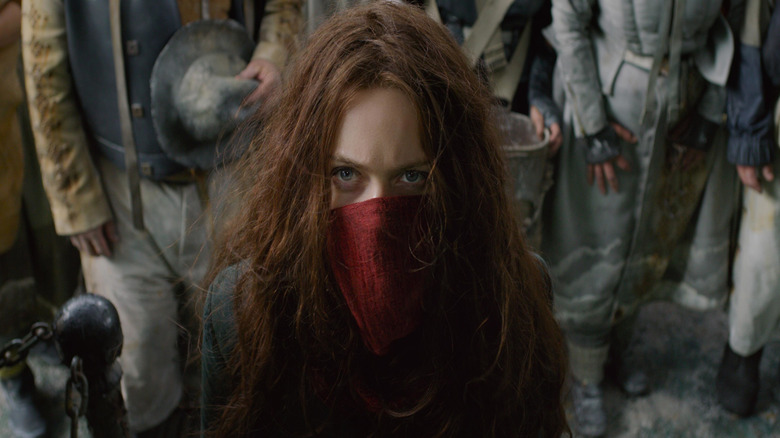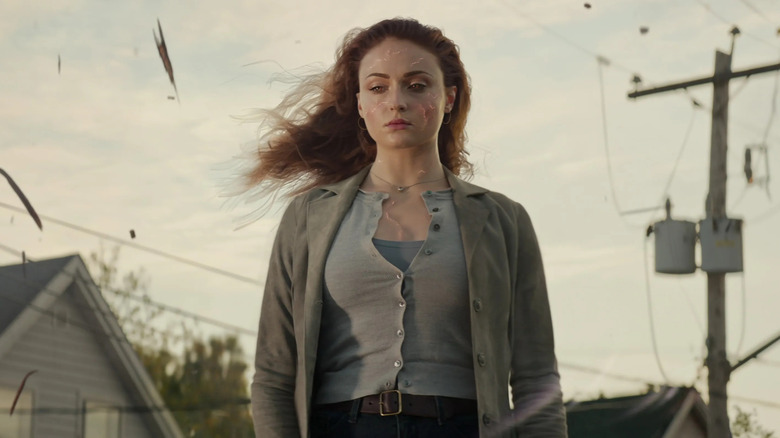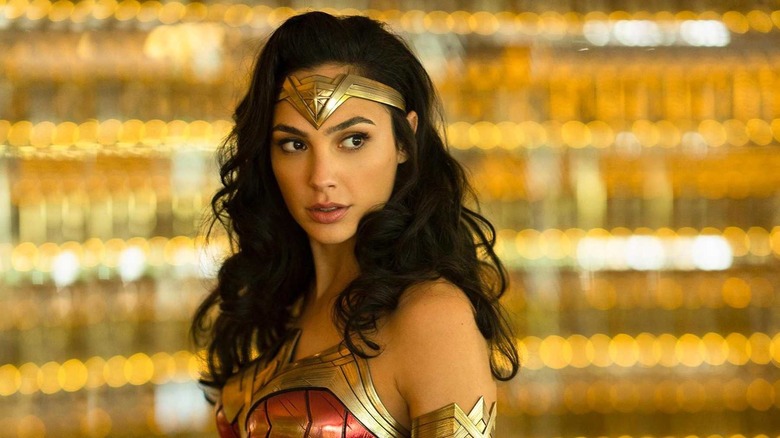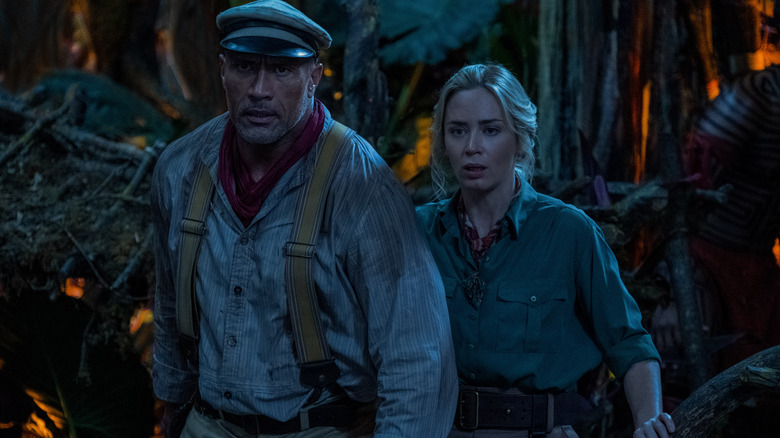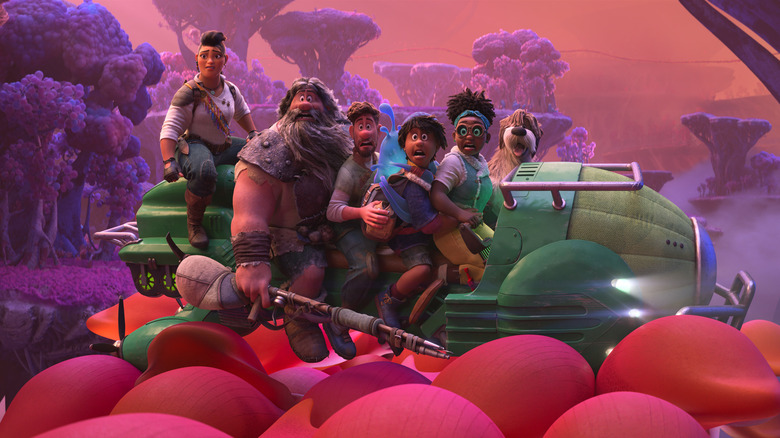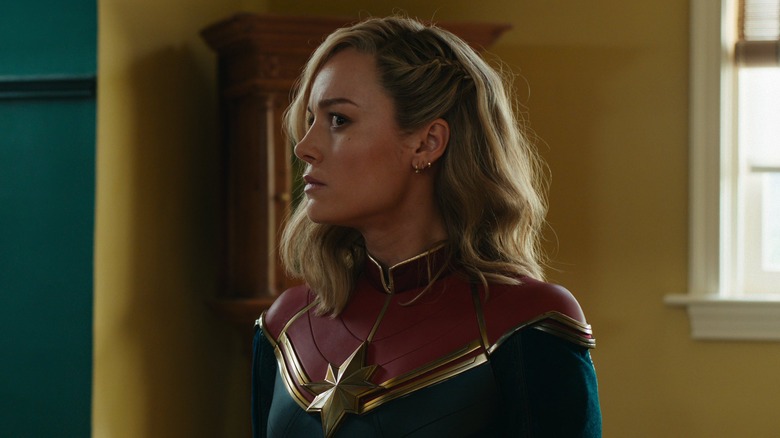The Biggest Box Office Bomb, Every Year Since 1990
Box office bombs have always been part of the fabric of Hollywood. In examining the countless flops that have been unleashed upon the public over the years, one can discern many intriguing trends related to the habits of the moviegoing public. These include what kind of movies were especially prone to box office misfortune in certain eras of history.
In the early 1990s, for instance, box office bombs that put too much stock in star power were common, while the mid-to-late 2010s were riddled with massively expensive fantasy movies trying to revive tired brand names. Indeed, there's a lot cinephiles can learn from taking a look at famous failures, and that's especially true of the last few decades of box office duds. Let's take a look at these disasters year by year and see what they have to tell us.
1990: Bonfire of the Vanities
Sometimes, you can get all the big-name talent in the world, and it still can't draw in audiences. Case in point: "The Bonfire of the Vanities," a 1990 film adaptation of the Tom Wolfe novel of the same name. This film was directed by Brian De Palma and stars Tom Hanks, Bruce Willis, and Melanie Griffith — a truly astonishing collection of talent.
Yet none of them were able to drum up much interest in moviegoers, who largely gave the movie the cold shoulder. "Bonfire of the Vanities" only grossed $15.6 million on a $47 million budget. The production had talent to spare, but none of those famous faces were enough to save it at the box office.
1991: Hudson Hawk
"Catch the Hawk!" proclaimed the poster for "Hudson Hawk." It was an order that general audiences had no interest in following. Grossing $17 million on a $65 million budget, "Hudson Hawk" was a box office flop. That abysmal sum made it one of the lowest grossing post-"Die Hard" Bruce Willis vehicles up to that point.
In addition to a misguided marketing campaign that assumed audiences already had a vested interest in the Hudson Hawk character, this action-comedy was plagued by an unwieldy price tag: "Hudson Hawk's" out-of-control budget ensured that the film would have needed a miracle to be profitable. Such a miracle never surfaced, as audiences made it abundantly clear that they were not interested in catching "the hawk."
1992: Hero
Many box office flops are also critically derided. In the case of the 1992 Dustin Hoffman vehicle "Hero," though, we see a box office dud that actually scored generally positive reviews. However, that wasn't enough to save this project, which ended up grossing only $66 million on a $42 million budget.
Part of the problem here was the oversized budget. "Hero" is as homage to wacky old-school comedies, which is the kind of project that doesn't generate massive box office returns, let alone ones that can justify a $42 million price tag. But even though its ill-matched budget ended up making it a loser, "Hero" can comfort itself with its reviews, which few other duds of this caliber have.
1993: Last Action Hero
Arnold Schwarzenegger was an unstoppable box office juggernaut in the early 1990s. Of course, no movie star has an unblemished track record, and Schwarzenegger's big stumble came with "Last Action Hero." An $85 million project, "Last Action Hero" grossed just $137.7 million worldwide, a significant step down from Schwarzenegger's biggest movies.
While "Last Action Hero" faced negative reviews from critics, its biggest challenge was in facing a movie that opened just one week earlier. Schwarzenegger may have had hits in the past, but "Last Action Hero" stood no chance opening just days after "Jurassic Park." While that Steven Spielberg movie broke box office records, "Last Action Hero" went in the opposite direction by becoming one of the earliest examples of a Schwarzenegger vehicle losing quite a bit of cash.
1994: North
For his first five movies, director Rob Reiner was on a hot streak. So beloved were Reiner's initial works that he remains one of only two filmmakers in history to have three directorial efforts receive A+ CinemaScore grades. All that success came crashing down with the 1994 film "North," however, which was reviled by moviegoers and critics alike.
Produced on a $40 million budget, "North" grossed a disastrous $7.1 million worldwide. Not only was it a costly dud, it proved a turning point in Reiner's career as a filmmaker. Though he's gone on to direct the occasional hit (like "The American President" and "The Bucket List"), Reiner has never returned to the constant success he enjoyed before "North" derailed his career.
1995: Cutthroat Island
Given the "Pirates of the Caribbean" movies' success, it can be weird to hear that Hollywood once considered pirate movies to be instant box office poison. But it's true, and that reputation was mainly due to titles like "Cutthroat Island."
This swashbuckling adventure, helmed by Geena Davis and Matthew Modine, had a budget of $98 million, a ridiculous sum for a movie that isn't based on a famous pre-existing property. Spending all of that cash didn't result in a movie audiences wanted to actually see, as "Cutthroat Island" made a disastrous $18.5 million worldwide.
It was the final twist of the knife in the heart of its production company, Carolco Pictures, which had filed for bankruptcy a month prior to the atrocious performance of "Cutthroat Island." Thus the pirate genre became marooned, until Jack Sparrow came along.
1996: Mary Reilly
"If "Mary Reilly" falters at the box office," The Washington Post wrote before the film's debut, "it will not be a bomb on the order of "Heaven's Gate" or "Howard the Duck." It will be a smaller failure, but a bitter disappointment to the well-meaning filmmakers who wanted to make ... a commercial as well as an artistic success."
In fact, an even worse fate awaited "Mary Reilly," a romantic drama that grossed a disastrous $12.9 million on a $47 million budget. Release date delays and behind-the-scenes difficulties tainted the film's reputation, while TriStar Pictures gave the film a meager release. On opening weekend, the studio put "Mary Reilly" in only 1,470 locations, a lower theater count than all but two other movies in the top 10. With these factors in play, "Mary Reilly" ended up having a truly terrifying box office run.
1997: Fathers' Day
How could a movie pairing up Robin Williams and Billy Crystal circa 1997 miss at the box office? Despite the two men's sterling track records, "Fathers' Day" flopped hard, taking home a lacking $35.6 million worldwide on an $85 million budget. That's a terrible haul, particularly in the context of the box office gains its leading stars had previously garnered. "Fathers' Day" became Williams' lowest-grossing star vehicle since "Toys" five years prior, and Crystal's third-lowest-grossing.
"Fathers' Day" dragged down its two leading men with dismal reviews and an overly-familiar premise. A puzzling release date also saw "Fathers' Day" opening a week after the initial "Austin Powers" movie, and a whole month before the actual Fathers' Day holiday. This further sank a movie starring two seemingly bulletproof comedians.
1998: Jack Frost
When you think of Christmas movies, you're bound to think of cuddly characters like the exuberant Buddy the Elf and the kind-hearted Kris Kringle from "Miracle on 34th Street." On the opposite end of that spectrum is the titular lead of "Jack Frost."
"Jack Frost" tells the story of a dad (Michael Keaton) who dies and comes back to life as his kid's snowman. The snowman version of Jack is brought to life through CGI effects that make the chilly creation more unnerving than lovable. Perhaps that's why audiences stayed away from the movie altogether.
With an $85 million budget, "Jack Frost" only made $34.5 million worldwide. It also faced competition in its December 1998 release from other family movies like "The Prince of Egypt" and "A Bug's Life." Unlike "Jack Frost," none of the characters in those movies are likely to instill nightmares in kid viewers.
1999: The 13th Warrior
Adapting a Michael Crichton book made for a big box office hit with "Jurassic Park." Of course, that movie didn't become a phenomenon solely because of its source material, but studios still spent much of the rest of the 1990s adapting other Crichton books in the hopes of striking it rich. Case in point: "The 13th Warrior," based on Crichton's book "Eaters of the Dead," starring Antonio Banderas as the traveling poet Ahmed Ibh Fahdlan.
Released in August 1999, "The 13th Warrior" was a gigantic flop, grossing a terrible $61.7 million worldwide on a budget projected to have been a staggering $125 million. "The 13th Warrior" served a devastating blow to the idea that all film adaptations of Crichton novels would be hits the size of "Jurassic Park."
2000: Titan A.E.
"Titan A.E." had a number of positive factors in its favor, including the presence of director Don Bluth, who had previously helmed "An American Tail" and "Anastasia." Unfortunately, nothing could help "Titan A.E." at the worldwide box office, where it grossed just $36.7 million on a $75 million budget.
The fallout from this box office failure was tremendous. Within weeks, "Titan A.E." distributor 20th Century Fox closed its animation studio. Years after its release, former 20th Century Fox Animation head Chris Meledandri stated that "Titan A.E." lost $100 million at the box office. Even with some big-name filmmaking talent at its back, the movie was a cosmic castaway.
2001: Final Fantasy: The Spirits Within
Generally speaking, feature-length animation is seen as being strictly for children. Even the few exceptions to that rule, like "Fritz the Cat" and "Sausage Party," have to flaunt the fact that they're subverting the expected norms of children's entertainment. A rare adults-only American cartoon made it to theaters in 2001, however: "Final Fantasy: The Spirits Within."
Sadly, "The Spirits Within" grossed only $85.1 million worldwide on a $137 million budget. Audiences tended to find the film's eerily-realistic CG animation more off-putting than enticing, while a surge of action-oriented cartoons in the early 2000s (think "Titan A.E". and "Atlantis: The Lost Empire") made it hard for "The Spirits Within" to stand out. Thus, it was chalked up as another moment of struggle in the history of adult animation.
2002: The Adventures of Pluto Nash
Eddie Murphy's box office highs have been incredibly high, but his box office lows have been just as low. Enter "The Adventures of Pluto Nash," whose box office haul made "Meet Dave" look like "The Nutty Professor."
"Pluto Nash" didn't just underperform; it crashed and burned with just $7.1 million earned worldwide on a $100 million budget. That price tag may have been necessary to bring the movie's various sci-fi sets and costumes to life, but it did nothing to coerce moviegoers to shell out for the flick. "Pluto Nash was further done in by utterly toxic reviews. All of these factors kept the film from soaring into the stars at the box office.
2003: Sinbad: Legend of the Seven Seas
Hand-drawn animation at DreamWorks went out not with a bang, but a whimper in "Sinbad: Legend of the Seven Seas." While the studio's animation wing has seen its share of box office duds in its time, none have been quite as cataclysmic as "Sinbad." Released just before the Fourth of July, "Sinbad" grossed $80.7 million worldwide on a $60 million budget. That's a far cry from the $940 million worldwide haul of "Finding Nemo" from that same summer.
As a result of "Sinbad's" box office failure, DreamWorks Animation lost $125 million and has never returned to making hand-drawn animation. "Sinbad" became known best as a meek farewell to the studio's foray into two-dimensional cartoons.
2004: The Alamo
"Remember the Alamo!" So goes the famous saying that's been etched into American history. But does anyone remember 2004's "The Alamo," the big-budget movie based on the historic fight? Despite being rooted in such a famous event, "The Alamo" grossed only $25.8 million on an alleged budget of $125 million, a price tag widely reported to be lower than its actual costs.
Whatever its final budget, "The Alamo" was a massive money-loser. Chief among its problems is that movies based on the events at the Alamo have a dismal box office track record. Plus, competition from "The Passion of the Christ" cemented the film's failure. Although "The Alamo" may be long forgotten, its enormous failure at the worldwide box office will never be lost to history.
2005: Stealth
People love robots. People love "Top Gun." In 2005, somebody at Columbia asked, "Why not put them together?" and thus created "Stealth." A rare leading man role for Josh Lucas, the film co-stars Jessica Biel and Jamie Foxx in a high-concept summer blockbuster that moviegoers had no interest in. Despite costing $135 million to produce, a cushy July 2005 release date, and the fact that it featured one of Foxx's first roles after he won an Oscar for "Ray," "Stealth" flopped mightily, grossing just $79.2 million at the worldwide box office.
In the years since its release, the financial failure of Stealth has been pinned on its generic marketing and premise. While people may love robots and "Top Gun," "Stealth" suggests people don't automatically love them together.
2006: Poseidon
A ship going awry worked like gangbusters at the box office for 1997's "Titanic" and 1972's "The Poseidon Adventure." So why didn't it work for "Poseidon?" This 2006 remake came armed with a $160 million budget meant to ensure the film would have enough spectacle to stand out in a crowded summertime marketplace. Unfortunately for "Poseidon," it sank without a trace, grossing only $181.6 million worldwide.
While the titular ship in "Poseidon" is capsized by a gigantic wave, the movie itself was hit hard by a competing summer blockbuster: "The Da Vinci Code." That movie generated so much conversation and buzz that it utterly wrecked its opponents. Sure, movies about ships running into trouble on the open sea worked in the past. But considering how hard it struggled to stand out against other summer movies, "Poseidon" proved you need more than that to be a hit.
2007: Evan Almighty
After "Bruce Almighty" made a massive $484.4 million at the worldwide box office, a sequel was inevitable. Such a follow-up emerged with "Evan Almighty," which traded the first movie's leading man Jim Carrey for Steve Carell. Hot off "The 40-Year-Old-Virgin," Carell was loved by audiences, but he didn't have anywhere near Carrey's box office track record, let alone a track record that could justify the sequel's extravagant $175 million budget.
The result was a movie that grossed just $174.4 million worldwide — roughly 40% of the worldwide haul of "Bruce Almighty," despite costing more than twice what the earlier film did. A "Bruce Almighty" sequel was never going to be cheap, but the soaring budget of "Evan Almighty" made it an inevitable money-loser.
2008: Speed Racer
Today, "Speed Racer" is widely regarded as a cult hit. In its initial theatrical release, though, it was widely rejected by the general moviegoing public. Armed with a massive publicity campaign and the distinction of being the first Wachowski-directed movie since the "Matrix" trilogy, "Speed Racer" still managed to crash and burn with just $93.9 million earned on a $120 million budget.
The fact that "Speed Racer" wasn't an immediately recognizable brand name for many moviegoers may have put a bump in the film's road, but the real challenge came from its release date. It had to compete with "Iron Man," herald of the MCU age, leaving no room for the oddball anime adaptation at the box office. However, unlike many blockbuster duds, "Speed Racer" has managed to keep on trucking in the hearts of moviegoers long after its theatrical run ended.
2009: A Christmas Carol
It's always a curious phenomenon when studios try to replicate a movie that wasn't an enormous hit. 2004's "The Polar Express," for example, still hasn't managed to double its $165 million budget at the worldwide box office. But Disney wanted their own darkly fantastic Christmas movie, and so "Polar Express" director Robert Zemeckis was hired to helm a motion-capture-animated take on "A Christmas Carol."
The film was roughly as successful as "The Polar Express," earning $325 million worldwide, but its $200 million budget outstripped its predecessor's. As a result, Disney actually lost a sizable chunk of change on the project, with The Los Angeles Times projecting a loss in the $50-to-100 million range. Here we have a prime example of why making knock-offs of barely profitable movies isn't a recipe for success.
2010: How Do You Know
When it comes to movies that lose excessive amounts of money, the usual culprits are big-budget summer blockbusters gone awry. That wasn't the case with "How Do You Know," a romantic comedy that may not have featured costly CGI robots but nonetheless proved to be a massive flop.
Released in December 2010, "How Do You Know" is a far cry from the lucrative titles directed by James L. Brooks in the past, like "As Good As It Gets." "How Do You Know" grossed just $48.6 million worldwide against a $120 million budget. How did it rack up such an expensive price tag, you ask? It's all thanks to its star-studded cast and crew: $50 million of the film's budget went to its megawatt talent. These kinds of exorbitant costs set this rom-com up for a legendarily disastrous box office performance.
2011: Mars Needs Moms
Many of Disney's animated films are household names beloved by kids and adults alike. "Mars Needs Moms" is not one of those films. Released in March 2011, this motion capture-heavy animated flick grossed just $39.2 million on a $150 million budget. After its opening weekend came and went, The Hollywood Reporter declared that "Mars Needs Moms" would end up being one of the biggest money-losers in the history of movies – a far cry from the large amount of profit generated by past Disney cartoons.
The film was widely derided for a number of its creative choices, including poorly-executed comedy and the decision to have Seth Green provide motion capture for the film's adolescent protagonist. These problems kept "Mars Needs Moms" grounded to Earth, and made it a rare Disney animation disaster.
2012: John Carter
Once upon a time, John Carter was a groundbreaking character in the world of science fiction literature. In the modern world, John Carter is more synonymous with headlining one of the biggest box office flops of all time.
2012's "John Carter" amassed only $284.1 million worldwide on a $250 million budget. Theories regarding why the movie became such a massive non-starter are numerous. The prevailing ones highlight Disney's decision to minimize its distinct sci-fi elements in its marketing (including changing the film's title from "John Carter of Mars").
Whatever the reason for its financial misery, "John Carter" snowballed into a $200 million writedown for the company, cementing "John Carter" as shorthand for "costly box office flop."
2013: The Lone Ranger
In 2011, Disney halted production on its live-action blockbuster adaptation of "The Lone Ranger." The budget had spiraled out of control and Disney didn't see it being worth the financial risk. Some changes were made and the studio relented, allowing the film to move forward. That would turn out to be a fatal mistake.
Grossing $260.5 million on a $215 million budget, "The Lone Ranger" was an enormous failure. Not two months after its release, Disney announced that they stood to lose as much as $190 million on the project. The limited international appeal of Westerns always made an expensive take on "The Lone Ranger" a fool's errand: The film would have had to be a record-breaking behemoth to be remotely profitable. Disney should have stuck to their initial instincts and let this version of "The Lone Ranger" ride off into the sunset.
2014: Legends of Oz: Dorothy's Return
1939's "The Wizard of Oz's" fame has been both blessing and curse for later film adaptations of L. Frank Baum's beloved books. On the one hand, everyone still knows what the land of Oz is. On the other hand, "The Wizard of Oz" casts such an enormous shadow that it's hard to establish anything new.
"Legends of Oz: Dorothy's Return" was no exception to this trend, earning a paltry $21.7 million gross on a $70 million budget. But the new movie's problems ran deeper than its struggle to live up to the legacy of the beloved classic. There is also the fact that it was released by short-lived distributor Clarius Entertainment, as well as the film's cheap-looking animation. Even if "The Wizard of Oz" didn't exist, "Legends of Oz" was always going to struggle to get the attention of moviegoers.
2015: Pan
People just aren't interested in shelling out money to see live-action Peter Pan movies, apparently. 2003's Peter Pan was a box office flop, and even Steven Spielberg's "Hook" underperformed. Nobody learned that lesson in time to stop "Pan," though, a $150 million fantasy film that grossed just $128.3 million worldwide.
Though it presents itself as an origin story for Peter Pan, the marketing failed to offer anything new to moviegoers besides a less-diverse-than-usual cast for this story. Through these issues and more, "Pan" became the latest nail in the coffin of the boy who won't grow up's live-action prospects. No wonder Disney decided to send their latest live-action remake of "Peter Pan" straight to Disney+.
2016: Monster Trucks
Usually, movie studios wait until after a film is released to announce that they've lost money on it. But Paramount Pictures made history with "Monster Trucks" when, three months before it started playing in places like France, the studio announced it was taking a $115 million writedown on the film. Paramount's concerns turned out to be well-placed, as the $125-million budgeted "Monster Trucks" was greeted with a shrug by general moviegoers, grossing just $64.4 million worldwide.
In the years since its release, "Monster Trucks" has scored its fair share of defenders. Film critic Kristy Puchko praised the film's "absolute commitment to a premise conceived by a child (seriously)" as "winsome and unapologetically fun." However, decidedly not among those fans are Paramount Pictures' executives, who didn't even let "Monster Trucks" premiere worldwide before declaring it a significant box office flop.
2017: King Arthur: Legend of the Sword
Release date delays aren't inherently bad. In some instances, though, constant delays reflect a lack of confidence on the part of a studio. We'll never know for certain if the constant delays that plagued "King Arthur: Legend of the Sword" (originally scheduled for July 2016 before being shuffled to two different 2017 slots) were a sign that Warner Bros. lost faith in the film. But those repeated shifts didn't help the beleaguered project, which trudged into theaters with a $175 million budget and only grossed $148.6 million worldwide.
Initial plans to turn this into a cinematic universe went up in smoke thanks to a generic marketing campaign and a release date that saw "King Arthur: Legend of the Sword" open a week after the second "Guardians of the Galaxy" movie. After all those delays, audiences thought "King Arthur: Legend of the Sword" wasn't worth the wait.
2018: Mortal Engines
In the past, big-budget adaptations of fantasy novels penned by Peter Jackson and released in December had yielded box office success. However, that trend came to an abrupt halt with "Mortal Engines." Despite its pedigree, the whole project sputtered out; "Mortal Engines" grossed only $83.6 million on what is alleged to have been a $150 million budget.
What's the difference between "Mortal Engines" and earlier blockbusters written by Peter Jackson? Well, for one thing, "Mortal Engines" isn't based on source material quite as widely known as J.R.R. Tolkien's work. That lack of familiarity may well have resulted in "Mortal Engines" losing $174.8 million, a far cry from the kind of profits the individual "Lord of the Rings" movies brought in.
2019: Dark Phoenix
Just a few months after "Avengers: Endgame" broke box office records across the planet, "Dark Phoenix" debuted in theaters and amassed only $252.4 million worldwide. This isn't just below the norm for superhero movies — it's also a sizable step down from every other entry in the "X-Men" franchise up to that point.
That disparity is especially apparent in its domestic box office performance, which only grossed $65.8 million, well below the opening weekends of many past "X-Men" titles. Costing $200 million to make, "Dark Phoenix" ended up losing a whopping $133.3 million. If "Avengers: Endgame" showed the heights superhero movies can reach at the box office, "Dark Phoenix" demonstrated the financial nadir these films can plummet to.
2020: All movies
Something unprecedented happened in 2020: Theatrical movies came to a halt. Due to the COVID-19 pandemic, movie theaters closed, upending Hollywood in the process. As a result, the box office grosses of all 2020 titles were dramatically impacted. The includes everything from shelved titles to films like "Birds of Prey" and "Bloodshot" that were released in the first three months of 2020.
Calculating box office failures for 2020 is, accordingly, an impossible task. How can one determine what movies count as hits and flops, considering the staggering circumstances of the year? It's better to just say that, due to circumstances far beyond anyone's control, all movies in 2020 were the biggest box office failures of the year. Well, except for "Bad Boys for Life" – that one was an indisputably massive surprise hit lucky enough to debut before the pandemic shuttered theaters around the world.
2021: Jungle Cruise
In 2021, movie studios began regularly releasing new theatrical features again after theaters closed down in 2020. Save for a handful of hits like "Spider-Man: No Way Home" and "Candyman," many of these projects ended up flopping and losing money for their respective studios. This was no reflection of audiences losing their appetite for the big screen. Instead, the slow roll-out of a COVID-19 vaccine and choosing to simultaneously release many titles in theaters and streaming services undercut the box office potential of these projects. It didn't help that these movies had hefty budgets that could only be recovered in a pre-COVID box office landscape. A perfect example of a title that suffered from all these woes and more was 2021's biggest box office misfire, "Jungle Cruise."
In its theatrical run, the $200 million budgeted "Jungle Cruise" lost Disney approximately $151 million. Despite the Disney branding and a big co-star in Emily Blunt, "Jungle Cruise" only took in slightly more than "Rampage" in North America. Worse, it absolutely cratered overseas, where it failed to crack $100 million. This is despite past jungle adventure movies like "The Mummy" proving extremely lucrative overseas. Putting "Jungle Cruise" on PVOD on Disney+ just as it entered theaters doomed the project's box office run, while its $200 million budget was impossible to salvage in the constricted 2021 marketplace. Everything that could go wrong for "Jungle Cruise" went absolutely haywire, in the process crystallizing the various woes 2021 blockbusters struggled with.
2022: Strange World
If there's one style of movie that audiences keep telling Walt Disney Animation Studios they don't want, it's action-oriented animated features aimed at families. Back over Thanksgiving 2002, "Treasure Planet" bombed at the box office and lost the Mouse House tens of millions of dollars. Two decades later, Disney Animation once again launched a sci-fi feature full of explosions over the Turkey Day frame. This time around, the feature was "Strange World," and it somehow turned into an even bigger box office disaster for Disney. "Strange World" only made $73.6 million worldwide, a smaller global haul than "Treasure Planet" even before adjusting for inflation. It was also the costliest box office bomb of 2002, losing Disney as much as $197 million.
As to be expected for any movie that lost so much cash, there wasn't just one reason "Strange World" flopped. For one thing, the movie had historically poor word-of-mouth for a Walt Disney Animation Studios title, securing just a B CinemaScore grade from opening weekend audiences. Another problem was an infamously subdued marketing campaign that failed to turn "Strange World" into a must-see event. Most fatally, though, was simply that family moviegoers have constantly shown they're not interested in animated action-oriented sci-fi movies. "Strange World" was always going to have an uphill climb to win over audiences. Unfortunately, its box office failures turned out so severe that it became 2022's biggest box office bomb.
2023: The Marvels
2023 was not an ideal year for the Marvel Cinematic Universe. First "Ant-Man and the Wasp: Quantumania" received some of the worst reviews ever for a Marvel Studios movie and immediately got audiences dubious about following the MCU for years to come. That summer's event TV show "Secret Invasion," meanwhile, was met with even harsher buzz. This all culminated in the November 2023 release "The Marvels," which became the first Marvel Studios box office flop. Grossing only $206.1 million worldwide, its global box office haul was nowhere near what "Captain Marvel" procured from global audiences four years earlier. This Nia DaCosta directorial effort would eventually lose $237 million for Disney after costing $219.1 million to produce. That loss rendered it not just 2023's biggest box office failure but also one of the biggest box office flops in history.
There was a lot that went wrong with "The Marvels," including a marketing campaign that failed to emphasize an exciting new villain for its three superhero leads to fight. Other box office analysts speculated that an overdose of Marvel Studios programming on the small screen, not to mention increasing disillusionment with Marvel Cinematic Universe properties, inspired people to give "The Marvels" a shrug. Plus, "The Marvels" didn't have its actors out promoting the title thanks to the 2023 Screen Actor's Guild strike. A perfect storm of hostile elements coalesced to make "The Marvels" a bomb and a dreary capper to Marvel's dismal 2023.
2024: Joker: Folie à Deux
Matching the massive worldwide box office haul of the original "Joker" was always going to be a tough ask for "Joker: Folie à Deux." After all, that 2019 Todd Phillips directorial effort was the first R-rated movie in history to make over $1 billion worldwide, blowing away all pre-release expectations. Yet hopes were high that "Joker: Folie à Deux" could still leave a profound mark on the box office in its theatrical run. A month before its debut, initial tracking had the production easily clearing $100 million in its North American opening weekend. Those figures proved far out of reach. The feature cost $190 million to produce and only grossed $201.4 million worldwide, a catastrophic 82% decline from its predecessor's global haul.
How did "Joker: Folie à Deux" miss the punchline so badly at following up its predecessor? After all, projections for the sequel's theatrical run losses reached as high as $200 million! A key problem was simply that 2019's "Joker" was perceived as a one-and-done movie that audiences didn't crave a follow-up for. Immediately mixed reviews after its Venice Film Festival debut also ensured there was an entire month of negative buzz lurking around this movie's neck. It didn't help that, once "Joker: Folie à Deux" opened, it received some of the worst audience word-of-mouth ever for a comic book movie. While "Joker" was an astonishing runaway hit, everything that could go financially wrong with "Joker: Folie à Deux" went spectacularly awry.
